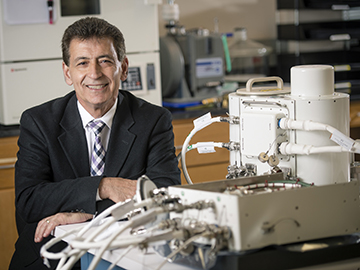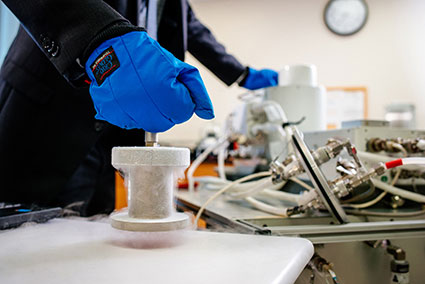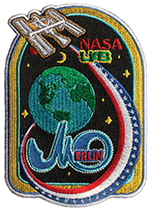EITD Director Reflects on How UAB Helped Shape a Career
 EITD Director Lee Moradi is pictured in this 2018 file photo with a piece of cold-stowage hardware built for the International Space Station.As a child, Lee Moradi thought of United States as the "Light of the Hill." Today, more than 40 years since he first emigrated from Iran, Moradi has found no place that embodies that American ideal more than at the University of Alabama at Birmingham.
EITD Director Lee Moradi is pictured in this 2018 file photo with a piece of cold-stowage hardware built for the International Space Station.As a child, Lee Moradi thought of United States as the "Light of the Hill." Today, more than 40 years since he first emigrated from Iran, Moradi has found no place that embodies that American ideal more than at the University of Alabama at Birmingham.
“The atmosphere of UAB, from the first time I came here until now, has always been so open and welcoming,” Moradi said. “As an international student, I looked at the people around me and I couldn’t tell much difference between UAB and Washington, D.C. or Los Angeles. It is a cosmopolitan environment that is different from what most people expect from a medium-sized city in Alabama.”
Moradi had no knowledge of UAB or Alabama when he moved to the U.S. in 1975. But when an early encounter brought him to Alabama, he found himself on a path that would repeatedly lead him to opportunities at UAB.
Today, Moradi holds three degrees from the UAB School of Engineering and is director of the school’s Engineering Innovation and Technology Development (EITD) research group. That team of roughly 40 engineers handles more than $50-million in contracts—most of which involve designing, building and maintaining hardware for NASA projects on board the International Space Station.
The EITD team’s success, Moradi says, is largely due to the inclusive environment that, over the course of four decades, kept calling him back. “UAB is a very nurturing university,” Moradi said. “It doesn’t matter where you come from or what discipline you’re in, if you have a curious mind are willing to put in the work, you will find opportunities to be successful here.”
From Tehran to …Boaz?
Moradi was born and raised in Tehran, the capital city of Iran, a country that in the 1960s and 70s was home to more than 100,000 Americans. “I grew up playing soccer and other games with American children,” he said. “That became my dream, to one day live and work in America.”
Ironically, that dream was realized through a disappointment. When Moradi applied to college in Iran, he was not accepted in the majors he had chosen. “They selected a very limited number of students in each discipline,” he said. “When I didn’t get accepted into medicine or engineering, my mother said, ‘Well, you can’t go to school in Iran; you will have to go to America.”
That’s why in the winter of 1975, Moradi found himself alone in Washington, D.C., ready to start a new life as a college student. “The cab driver who picked me up at the airport drove me around the city to show me the monuments. The streets were clean, but there was snow on the ground. It was beautiful. But as excited as I was to be in America, when I spent that first night here alone, I cried.”
Loneliness didn’t last long. Within a few days, Moradi formed friendships with other students from Iran. But instead of registering for classes at the University of Maryland where had already been accepted, he learned that he would have to take one year of English before he could register for other classes.
“I didn’t want to delay my education,” he said. “Someone told me that if I moved to Alabama, I could take classes immediately at Snead State Junior College. What are the odds that someone in Washington, D.C. would know about Snead State in Boaz, Alabama?”
In spite of the long odds, Moradi and some of his friends made the move to Boaz. Later, he would transfer to Calhoun Community College in Decatur, where he finished his associate’s degree in 1978. A year later, history would repeat itself in a way, when Moradi was enrolled at the University of Tennessee and found rules that encumbered education for immigrants. “My younger brother joined me in Tennessee, but he was still in high school,” Moradi said. “At that time, you couldn’t go to high school in Tennessee unless you had a Green Card. There were no restrictions in Birmingham, so I transferred to UAB.”
Obstacles and Opportunities
In Birmingham, a city that was still largely defined by racial strife of previous decades, Moradi says he found an engineering school with faculty who were strong sources of not only academic inspiration, but also of critical support during a difficult time. “I was a student when the Iran hostage crisis took place, and my world changed overnight,” he said. “I went from being popular to very unpopular. The Iranians I knew were just students, but people were suddenly suspicious of us.”
In that charged environment, Moradi said the engineering faculty were quick to speak up in support of the students, with former Dean Jim Woodward, Ph.D., going so far as to write op-eds for the UAB Reporter urging students to show tolerance and respect for their international classmates.
“That period of time remains vivid in my mind, even today,” Moradi said. “But I don’t remember it as a negative experience. It was a troubling time, but I remember mainly how the professors were so supportive, not just during that crisis, but afterward. They supported me academically, professionally, and personally. Dr. Joe Appleton, the founding dean, in particular, helped me get my first job, and he always pushed me to get a Ph.D.”
Aiming for the Stars
 An EITD engineer removes a sample from a rapid-freeze device the team developed for the International Space Station. In 2019, EITD was responsible for 17 simultaneous payloads on board the ISS.Moradi graduated from UAB with a general engineering degree with a focus in structural engineering. With a recommendation from Appleton, he got a job with a local construction firm. But when the economy tanked in 1983, that company went under, and Moradi moved to Huntsville where he found work with firms that did engineering work for NASA and the Department of Defense. Little did he know that that experience in Huntsville would lead him back to UAB.
An EITD engineer removes a sample from a rapid-freeze device the team developed for the International Space Station. In 2019, EITD was responsible for 17 simultaneous payloads on board the ISS.Moradi graduated from UAB with a general engineering degree with a focus in structural engineering. With a recommendation from Appleton, he got a job with a local construction firm. But when the economy tanked in 1983, that company went under, and Moradi moved to Huntsville where he found work with firms that did engineering work for NASA and the Department of Defense. Little did he know that that experience in Huntsville would lead him back to UAB.
“In the 1990s, an astronaut named Dr. Larry DeLucas was building a team at UAB to explore protein crystal growth,” Moradi said. “He started the Center for Biophysical Sciences and Engineering, and the research he was doing required engineers with NASA experience.”
Moradi moved back to UAB to work with DeLucas’ team of engineers, which quickly grew to more than 50. Years later, the fervor for that particular area of research began to cool down, but by then the UAB engineers had established themselves with NASA. They were asked to propose on upcoming hardware projects and were able to not only compete with industry leaders like Hamilton Sundstrand and Lockheed Martin, but win.
 “That was really the beginning of what would become EITD,” Moradi said. “Talk about blessed! None of this was by design. We came here to support Dr. DeLucas’ work in protein crystals, and to do that, we became experts at building thermal carriers. When the protein crystal growth experiments eventually slowed down, the demand for thermal carriers remained.”
“That was really the beginning of what would become EITD,” Moradi said. “Talk about blessed! None of this was by design. We came here to support Dr. DeLucas’ work in protein crystals, and to do that, we became experts at building thermal carriers. When the protein crystal growth experiments eventually slowed down, the demand for thermal carriers remained.”
Today, EITD is finishing up its third five-year contract and is scheduled to be awarded a fourth contract this fall. The engineering team, which grew to 50 people at the height of the CBSE and later shrank to a low of 16, has grown back to include around 40 engineers.
And in a place where Moradi was once the beneficiary of tolerance and support, he now finds himself as the benefactor for students and young engineers from all over the world. “If there is one secret to my professional success, it is that I have always tried to hire people who are smarter than me, and put them in position to succeed,” Moradi said. “You hear the same type of story over and over at UAB. I feel very fortunate to be a small part of that story.”